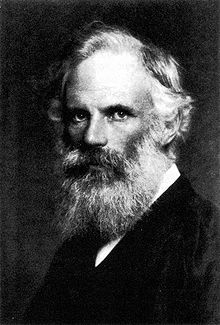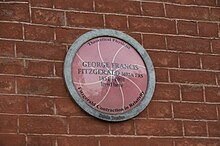George Francis FitzGerald
George Francis FitzGerald FRSE FTCD | |
|---|---|
 | |
| Born | 3 August 1851 |
| Died | 21 February 1901 (aged 49) Dublin, Ireland |
| Nationality | Irish |
| Awards | Royal Medal (1899) |
| Academic background | |
| Alma mater | Trinity College Dublin |
| Academic work | |
| Discipline | Physicist |
| Institutions | Trinity College Dublin |
| Special relativity |
|---|
 |
FitzGerald is known for his work in electromagnetic theory and for the
Life and work in physics
FitzGerald was born at No. 19, Lower Mount Street in
Along with Oliver Lodge, Oliver Heaviside and Heinrich Hertz, FitzGerald was a leading figure among the group of "Maxwellians" who revised, extended, clarified, and confirmed James Clerk Maxwell's mathematical theories of the electromagnetic field during the late 1870s and the 1880s.[4]
In 1883, following from
In 1883, he was elected Fellow of the Royal Society. In 1899, was awarded a Royal Medal for his investigations in theoretical physics. In 1900, he was made an honorary fellow of the Royal Society of Edinburgh.[6]
FitzGerald suffered from many digestive problems for much of his shortened life. He became very ill with stomach problems. He died at his home, 7 Ely Place[7] in Dublin, shortly after an operation on a perforated ulcer on 21 February 1901. He is buried in Mount Jerome cemetery.

Length contraction
FitzGerald is better known for his conjecture in his short letter to the editor of
The
Family
FitzGerald married, on 21 December 1885, Harriette Mary, daughter of the Reverend
FitzGerald was the nephew of George Johnstone Stoney, the Irish physicist who coined the term "electron". After the particles were discovered by J. J. Thomson and Walter Kaufmann in 1896, FitzGerald was the one to propose calling them electrons. FitzGerald was also the nephew of Bindon Blood Stoney, an eminent Irish engineer. His cousin was Edith Anne Stoney, a pioneer female medical physicist.[citation needed]
Flying experiments

FitzGerald, in common with others at the end of the nineteenth century, became obsessed with the desire to fly. His attempts in College Park, in Trinity College Dublin, in 1895 involved large numbers of students pulling tow-ropes attached to the Lilienthal glider, and attracted the attention of the people of Dublin, beyond the Nassau Street railings. FitzGerald took off his coat on these occasions, but retained his top hat, which was normal headgear for a Fellow at that time. The experiments were not crowned with success, and were eventually abandoned. The flying machine hung for many years in the Museum Building until an idle engineering student applied a match to the cord from which it was hanging. The flame travelled along the cord and consumed the glider before the helpless onlookers.[8]
References
- ISBN 978-0-387-31022-0. Retrieved 22 August 2012.
- ^ "Fitzgerald, George Francis | Dictionary of Irish Biography". www.dib.ie. Retrieved 21 February 2023.
- ^ "George FitzGerald - Biography". Maths History. Retrieved 21 February 2023.
- ^ Bruce J. Hunt (1991) The Maxwellians, Cornell University Press
- ^ Professor Reville, William (2001). George Francis FitzGerald – Eminent Irish Physicist Archived 29 November 2016 at the Wayback Machine
- ^ a b Lees, Charles Herbert (1912). . In Lee, Sidney (ed.). Dictionary of National Biography (2nd supplement). London: Smith, Elder & Co.
- ISBN 0-902-198-84-X. Archived from the original(PDF) on 24 January 2013. Retrieved 9 May 2016.
- ^ Bailey, Kenneth (1947). A History of Trinity College Dublin, 1892-1945. Dublin: The University Press. pp. 208–209.
Bibliography
- Jarret, Philip. "Soaring Inspiration: Otto Lilienthal's Influence in Britain". ISSN 0143-5450.
External links
 Quotations related to George Francis FitzGerald at Wikiquote
Quotations related to George Francis FitzGerald at Wikiquote- O'Connor, John J.; Robertson, Edmund F., "George Francis FitzGerald", MacTutor History of Mathematics Archive, University of St Andrews
- FitzGerald letters at the Royal Dublin Society, with digitized images of over 2000 letters to and from FitzGerald
- FitzGerald of Kilcarragh – Genealogical Pedigree of George Francis FitzGerald
